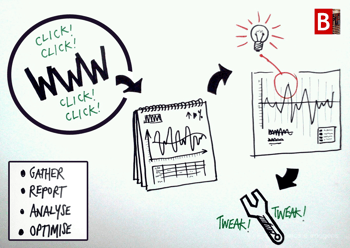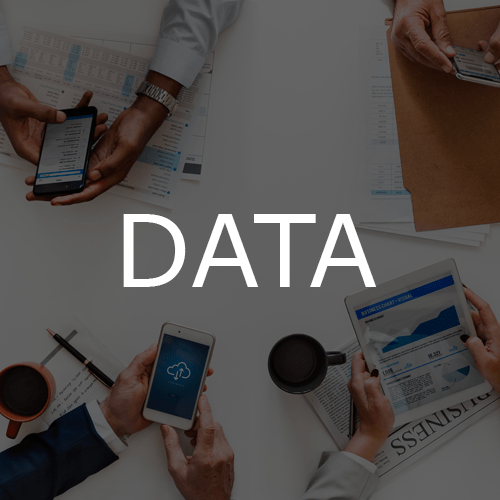At LaneTerralever, we’ve created a tight-knit team of specialists who work together to design and execute acquisition campaigns for our clients. One of our in-house service lines that is part of the Acquisition team is the Data & Analytics team. In this blog our Data & Analytics specialist, Valeria Lopez, gives a breakdown on reporting.
Some people may feel that data analysis is about as exciting as reading the phone book. If the data analysis you’re presenting is boring, you’re not presenting the real story. Looking at raw data can be overwhelming if you don’t know what to do with it. What does it all mean? Do you need to explain every metric available? How do we know if it was successful? These are all questions you may ask yourself when diving into data and trying to analyze it. When looking at data it can be like looking at a puzzle; the pieces are scattered everywhere and it’s your job to put it together into a cohesive picture. Before you get started, you have to know what the main business goal is. Much like building a puzzle, you need to know exactly what you’re working towards. It’s also wise to set expectations and have candid conversations with your team and client; many industry benchmarks can be unreliable, as each campaign, organization, and industry is unique. A smart way to approach this is to set your own benchmarks by looking at past performances for similar campaigns. As you look at metric-specific benchmarks, consider what the final goal is. In the past campaigns and current campaign, was the objective to raise brand awareness or increase sales? Understanding the end goal is important to see what metrics are relevant to support the success of the campaign and provide the team insights during and after the campaign.
Before you get started, you have to know what the main business goal is. Much like building a puzzle, you need to know exactly what you’re working towards. It’s also wise to set expectations and have candid conversations with your team and client; many industry benchmarks can be unreliable, as each campaign, organization, and industry is unique. A smart way to approach this is to set your own benchmarks by looking at past performances for similar campaigns. As you look at metric-specific benchmarks, consider what the final goal is. In the past campaigns and current campaign, was the objective to raise brand awareness or increase sales? Understanding the end goal is important to see what metrics are relevant to support the success of the campaign and provide the team insights during and after the campaign.
Once you have the framework, you need to establish a timeline and deliverable. How often will the data be measured? It can be daily, weekly, monthly, or quarterly depending on the campaign and client. For some sets of data, too frequent of data reviews can actually be a problem and lead to overly reactionary decisions, when a “wait and see” approach is better. It is the job of the data analyst to be the voice of reason and consultation for data collection cadence. The agreement of the final deliverable needs to be discussed early on in the timeline.
It’s also important to remember that the person or team receiving data and analysis are all very different. Some clients are data-driven and want all of the raw numbers with a short analysis, while others are more visual and need graphs, charts, and analysis to provide a quick write-up of what the data means. In either case, knowing what your audience wants will help structure the report.
At the end of the report deliverable timeline, you can start to build the puzzle and gather all of the pieces. It’s not uncommon to pull together data from various sources such as digital and traditional media, as well as SEO organic performance. You’ll need every single piece to make it work and see the bigger picture. Even if your client only wants certain metrics or channel performance, it is your job to look at anything that may affect the overall performance data in a positive or negative way. Every effort made impacts the final goal, so it’s important to fully understand each piece.
 While it’s important to understand every piece, it’s even more important to be objective with the data. Being heavily involved in a project is great until you have to take a step back and analyze your work. It’s very easy to “spin” data that makes you and your project look good, but at the end of the day that won’t help you or your client. Calling out positive metrics and behaviors is as important as negative ones. Not everything will end as a pretty picture with green arrows and positive numbers. A big part of what the story needs to include are action items and lessons learned from the data you’ve analyzed.
While it’s important to understand every piece, it’s even more important to be objective with the data. Being heavily involved in a project is great until you have to take a step back and analyze your work. It’s very easy to “spin” data that makes you and your project look good, but at the end of the day that won’t help you or your client. Calling out positive metrics and behaviors is as important as negative ones. Not everything will end as a pretty picture with green arrows and positive numbers. A big part of what the story needs to include are action items and lessons learned from the data you’ve analyzed.
Turning insights (the story you’ll create) into actionable items can be the most challenging part of the report if you’re not asking the right questions or including the right team. You’ll frequently ask yourself and the team: “Ok, but why did this happen?” or “What did we do to cause this?” There could be a myriad of reasons why things happen, seasonality, budget changing, testing targeting, or even new creative. Once you have the full picture, you’ll be able to know the steps the team will take next or for the next campaign. These changes may be based on lessons learned, or include new testing you’ll implement the next time. The report won’t have any value if you don’t act on the recommendations or consider lessons learned for future endeavors.




